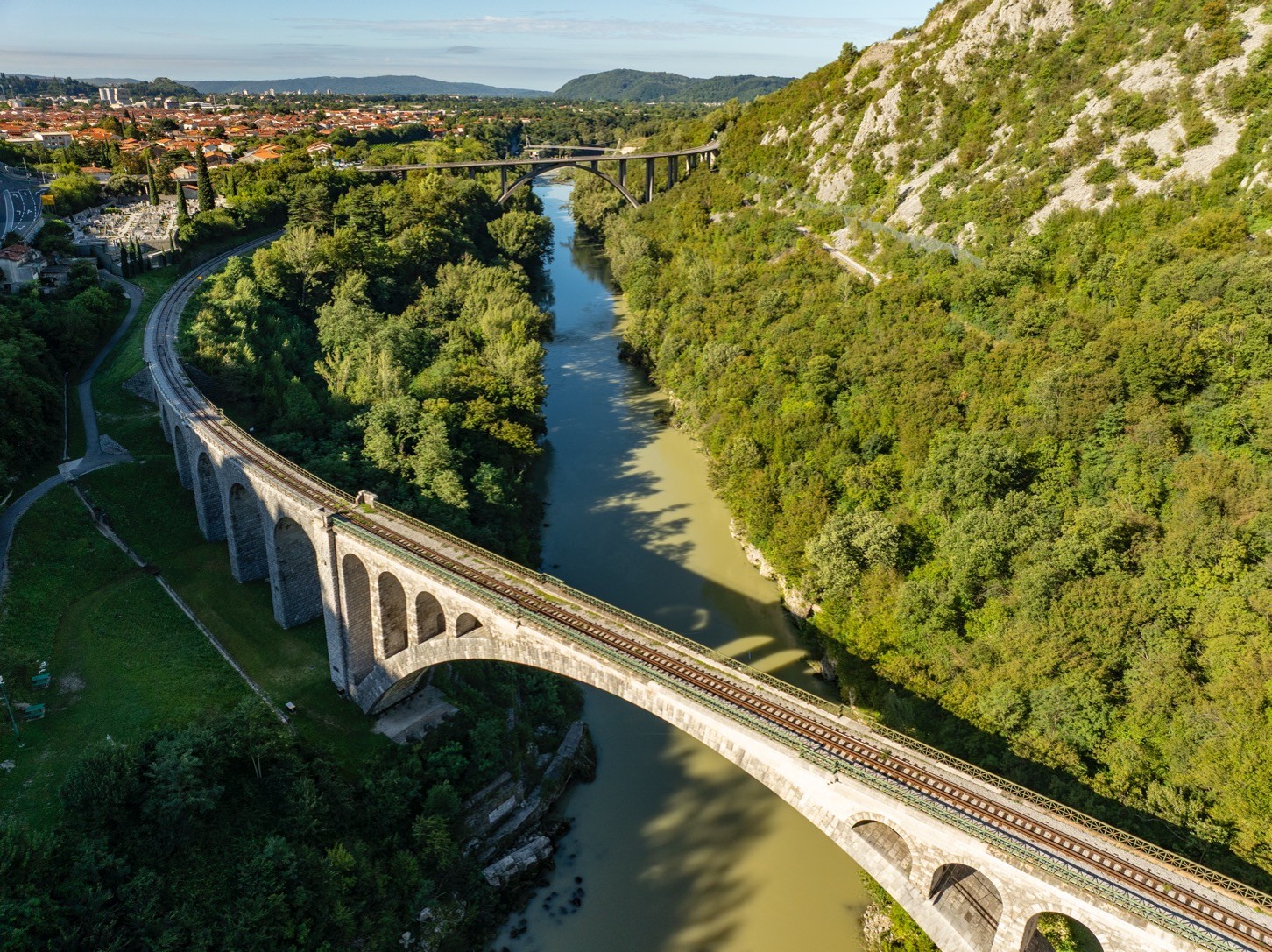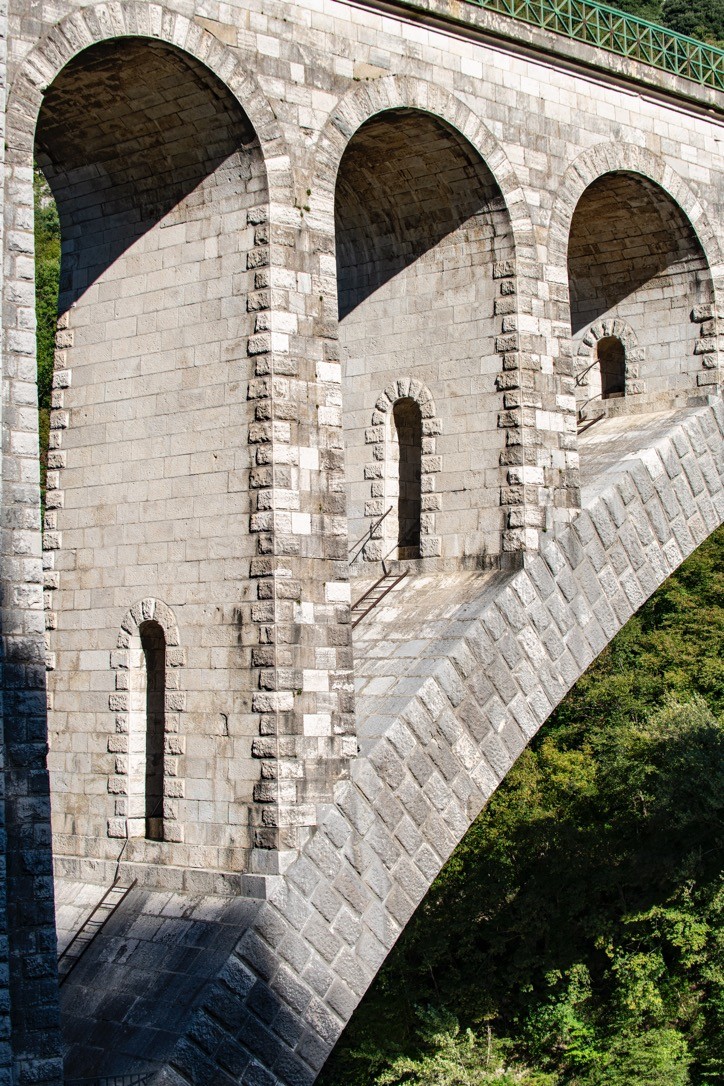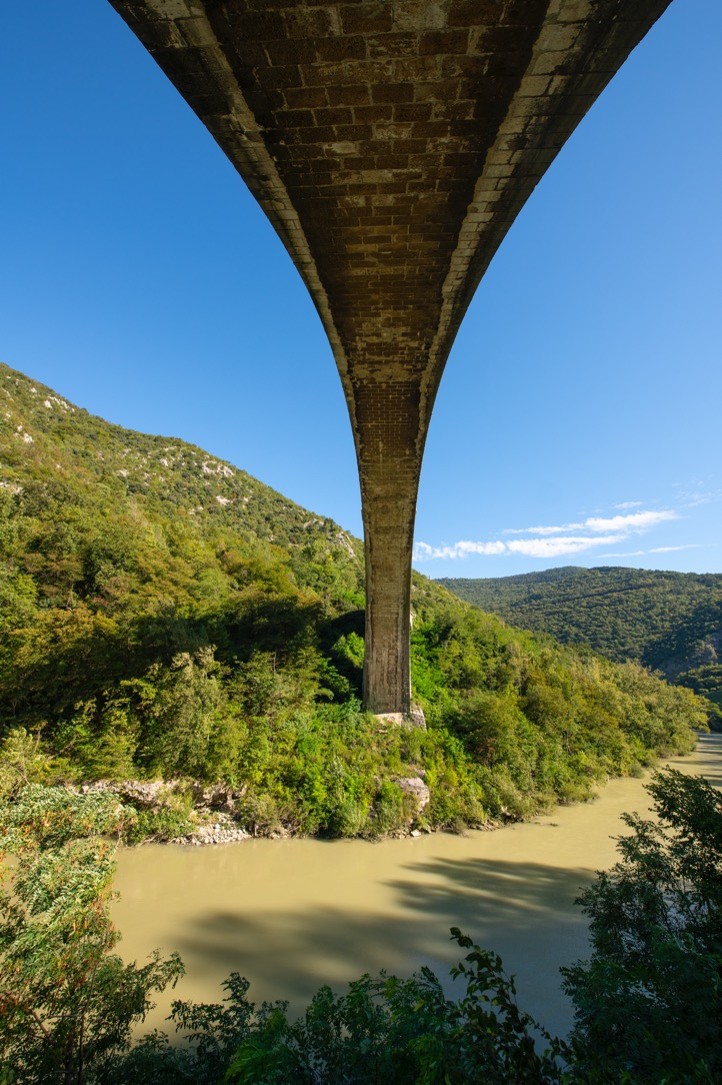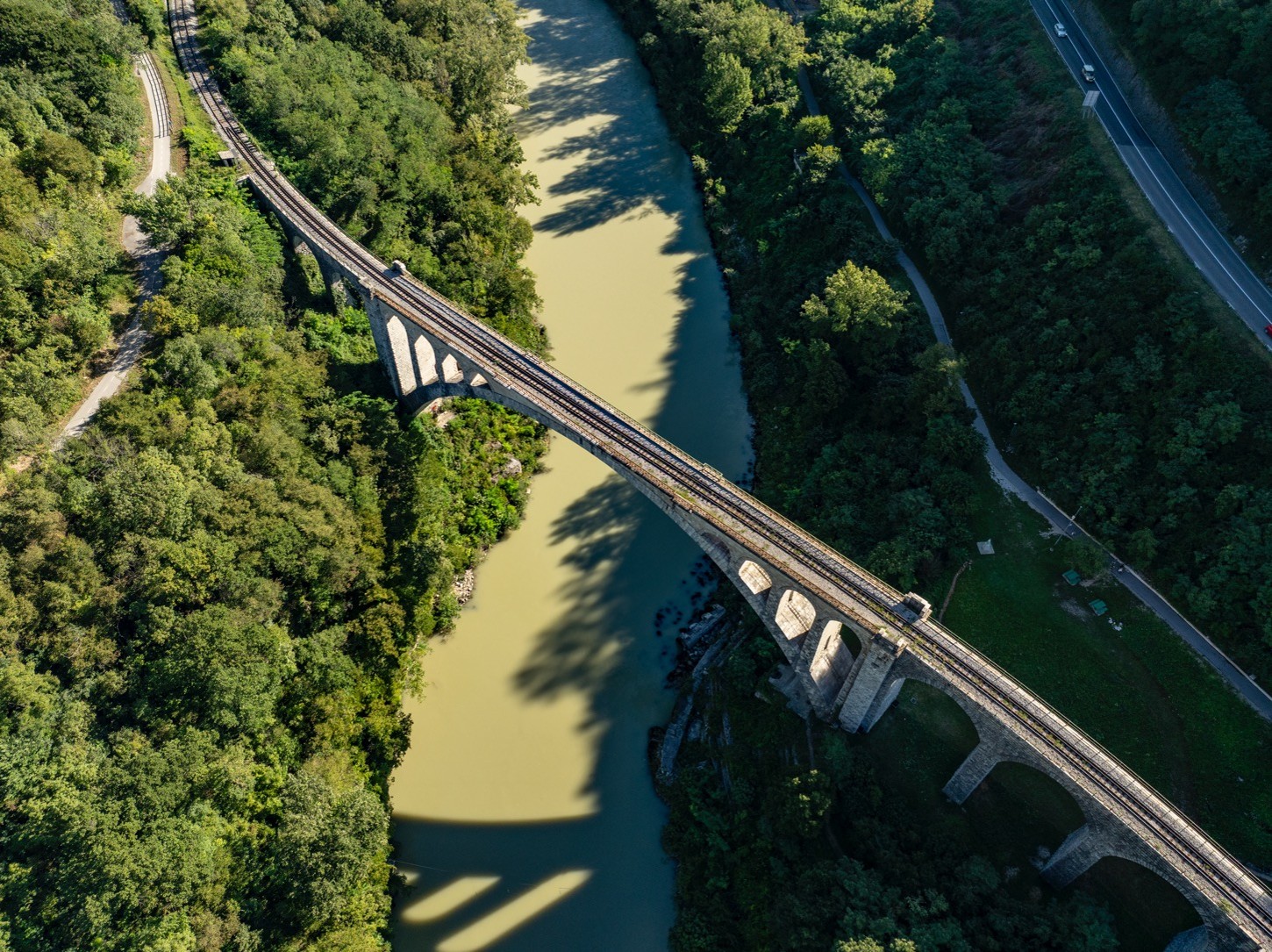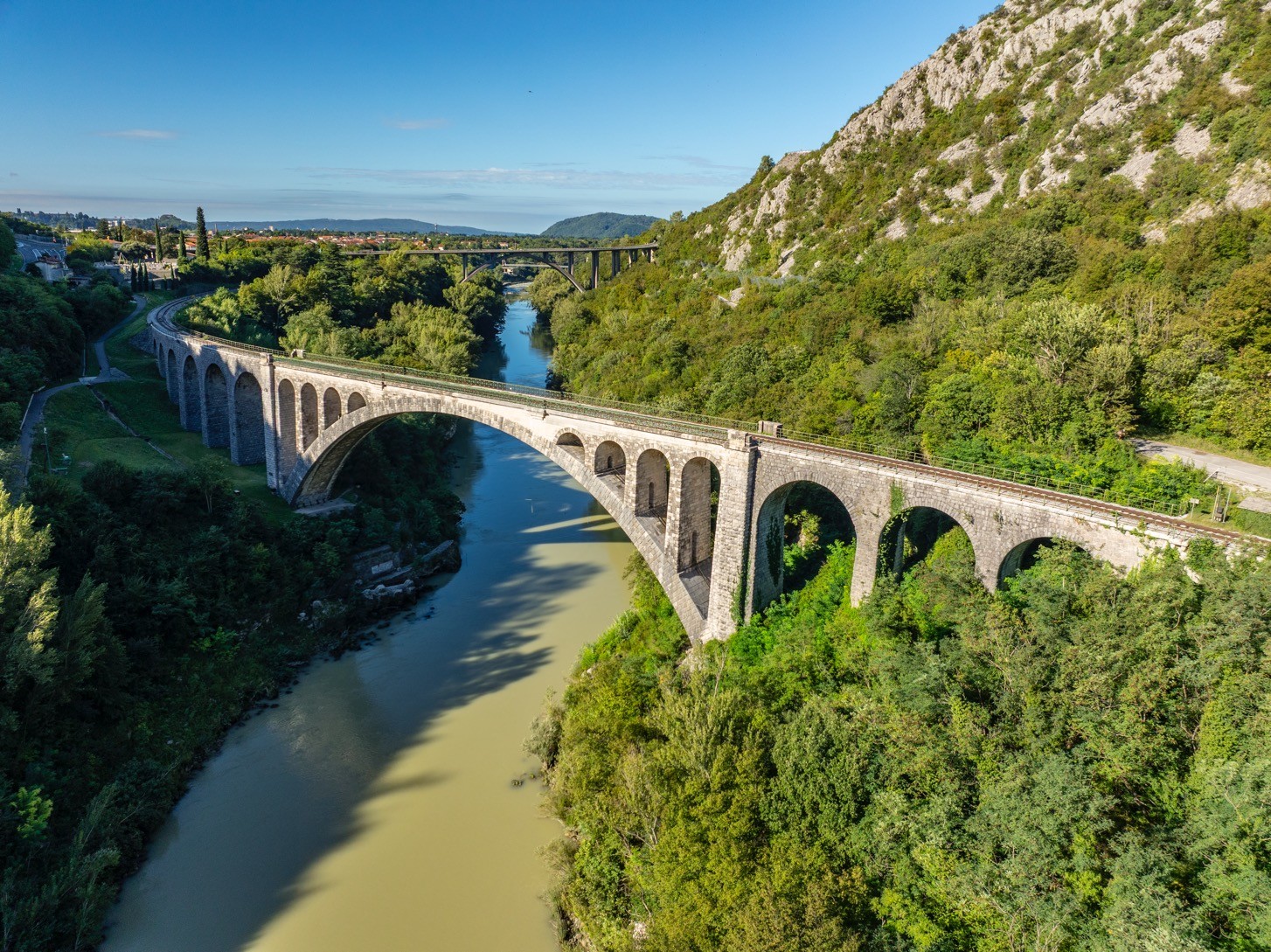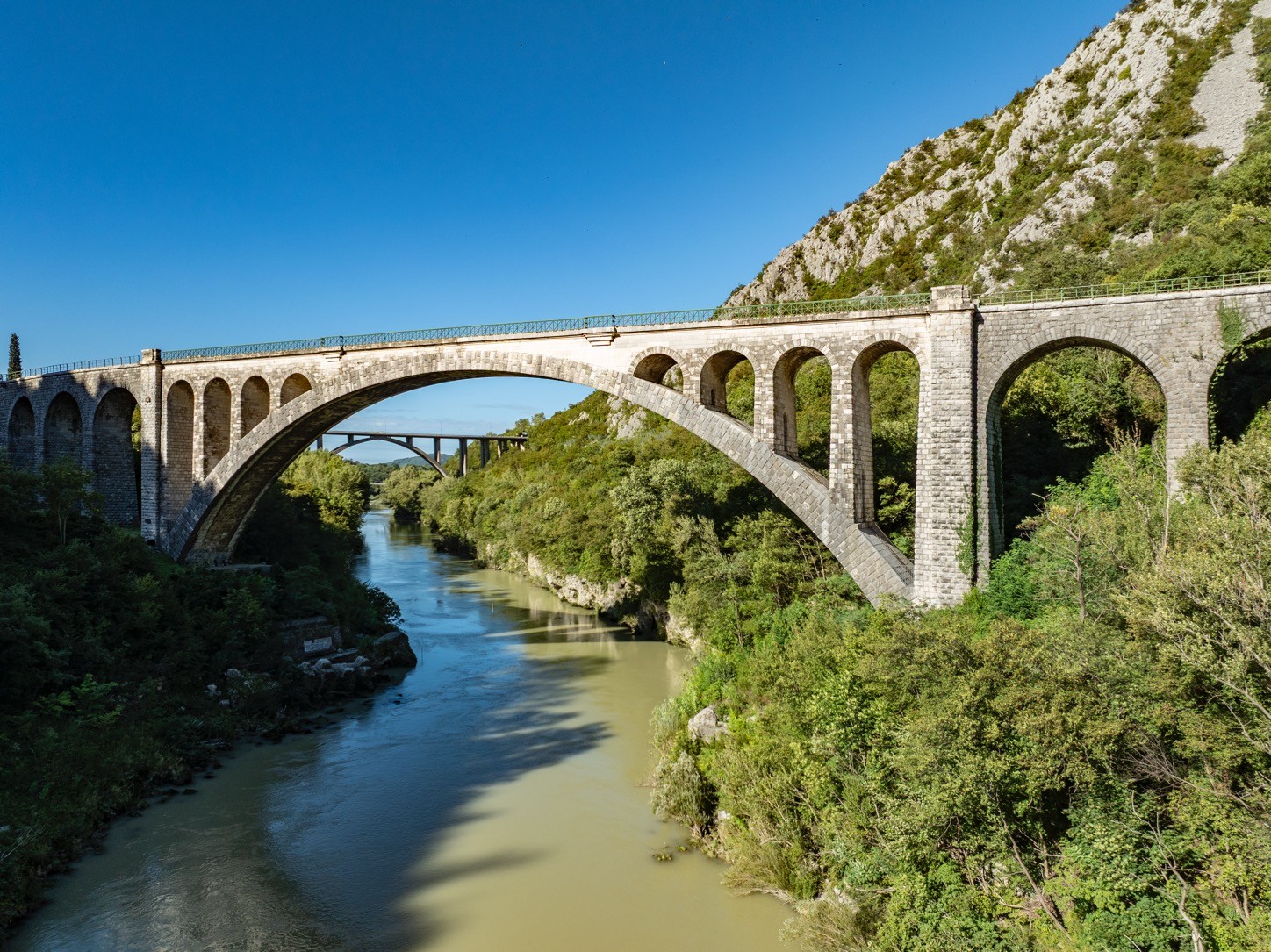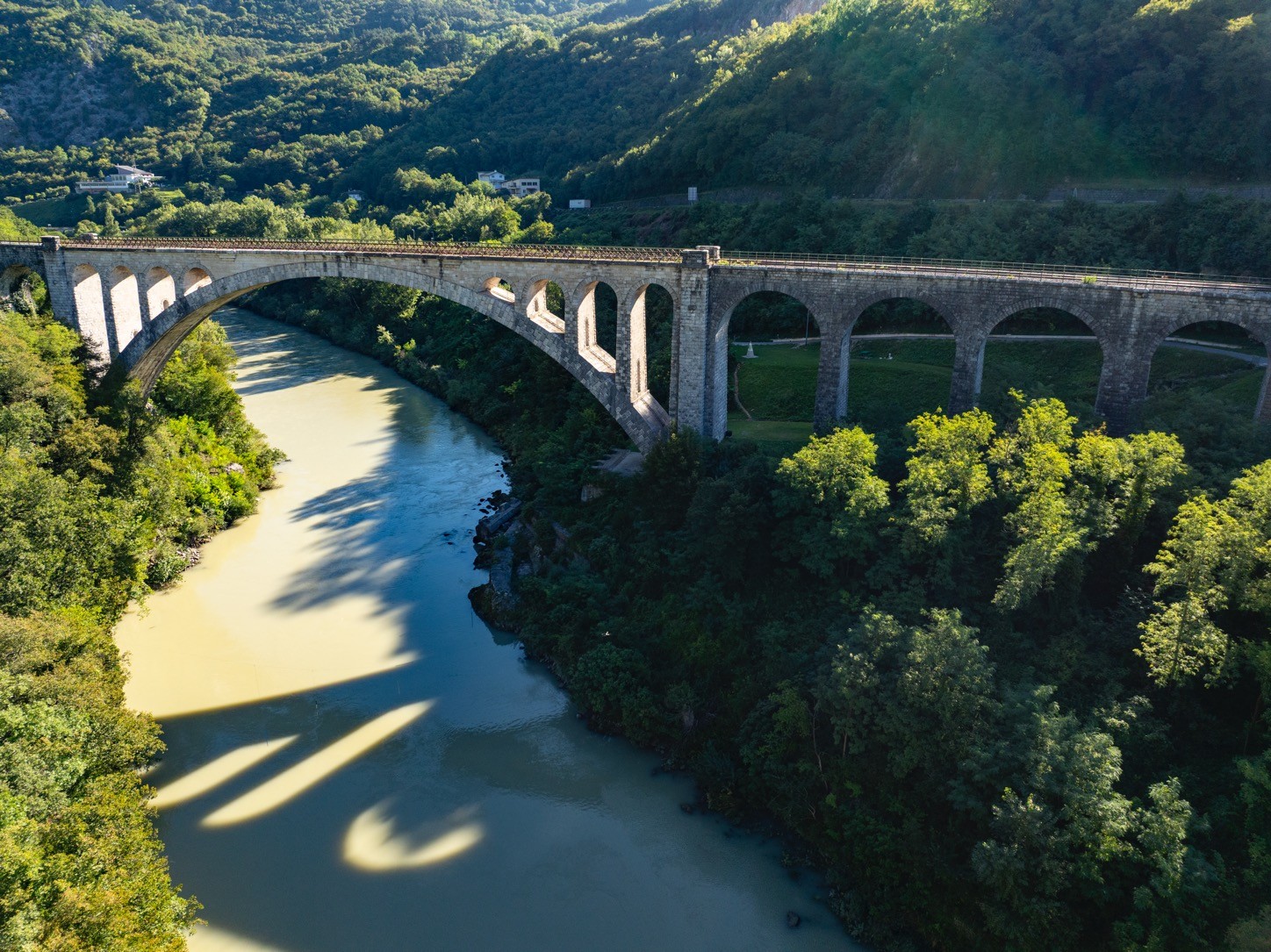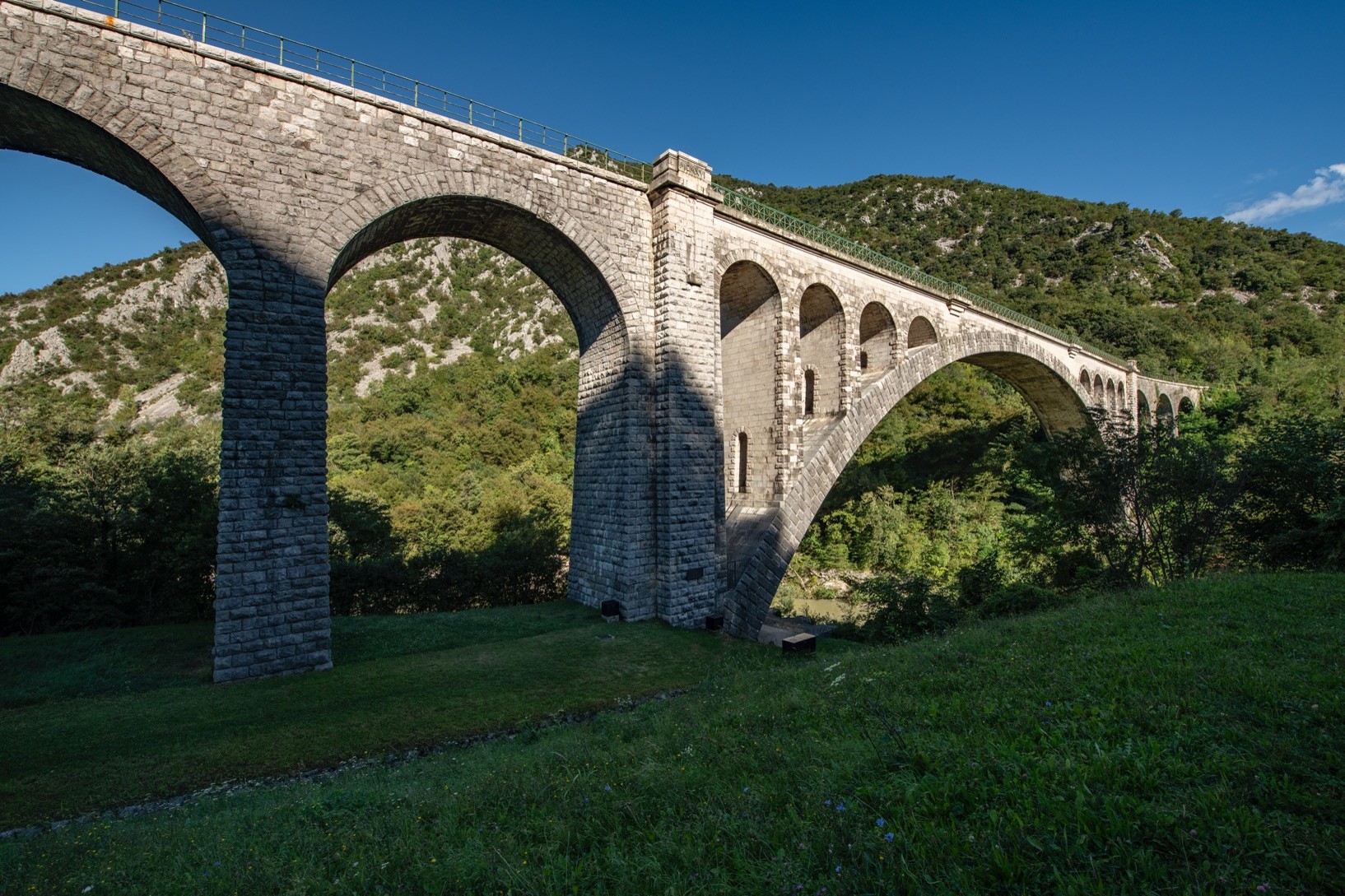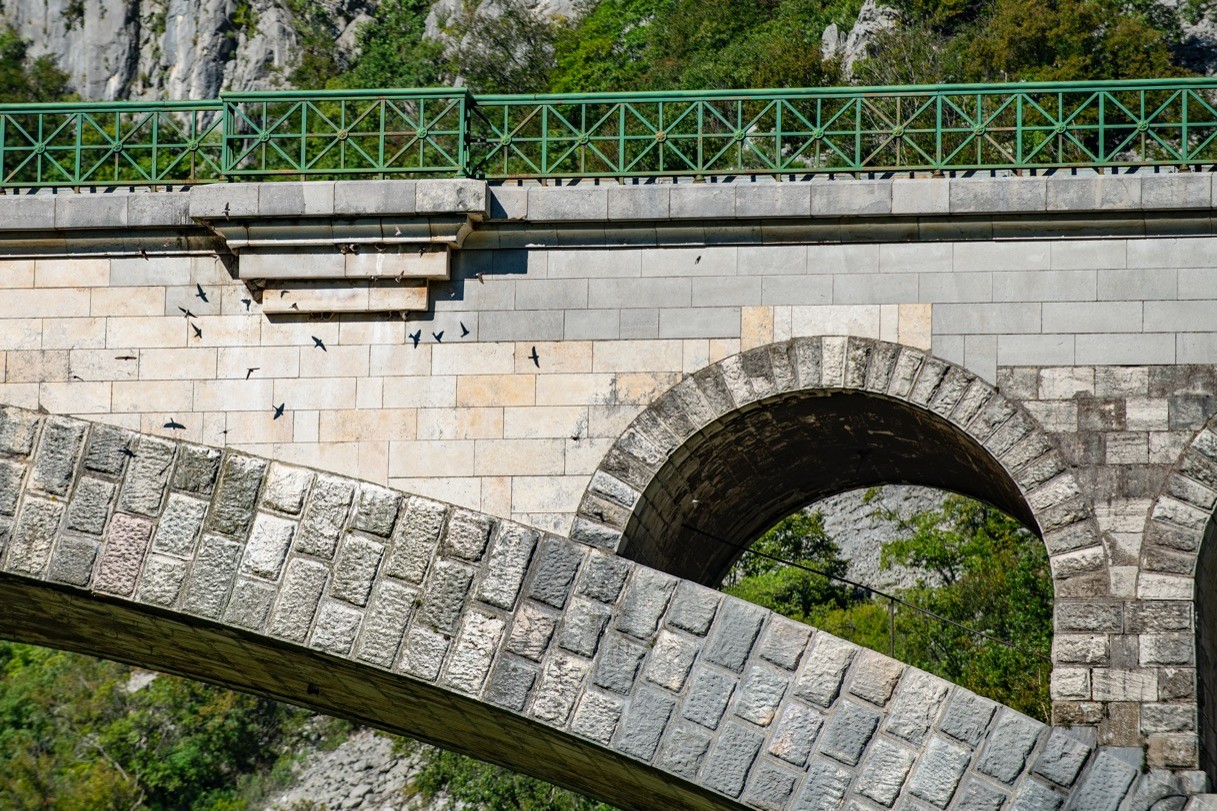salcano

Osimo road bridge
Gorazd HUMAR
HISTORY
THE BRIDGE REPRESENTS AN EXAMPLE OF THE EXCELLENT COLLABORATION BETWEEN ITALY AND FORMER YUGOSLAVIA
The 7.5-kilometre road linking Solkan (Salcano) to the Goriška Brda (Collio) was officially inaugurated in 1985. The route’s most significant structure is the masterfully engineered reinforced concrete arch bridge crossing the Soča-Isonzo River near Solkan. The bridge stretches 238 metres, featuring an impressive 102-metre arch.The construction of the bridge and road connecting Solkan to the Goriška Brda area tells a compelling story that is as complex as it is successful. The Collio-Brda road project stemmed from fruitful cooperation between Italian and Yugoslav authorities, culminating in the Osimo Treaties. These agreements, signed on 10 November 1975 in Osimo, an Italian town in the Marche region, resolved several longstanding border issues between the two nations. A key achievement was the plan to build a road across the Italian side of Mount Sabotino, which would significantly shorten the route into the Goriška Brda. Italy’s agreement to provide a 1.6-kilometre stretch within its territory for the new infrastructure marked a significant turning point in political relations between the two states, laying the groundwork for closer ties and future cooperation between the European countries.
The Osimo Treaties also regulated the new road’s technical aspects, which were further refined in detail. The agreement established that each country would build the road section within its own territory and set clear guidelines for traffic management along this border-crossing route. The Italian section was initially bordered by a metal fence, which was progressively removed following Slovenia’s entry into the European Union.
The Brda-Collio road and the bridge over the Soča-Isonzo were built between 1978 and 1985. This infrastructure significantly reduced the distance between the Goriška Brda and the regional centre, Nova Gorica, fostering the development of a predominantly agricultural area. The area has since evolved into an emerging tourism destination. Furthermore, the improved connectivity to eastern Collio has strengthened collaborative relationships with adjacent Italian municipalities.
The Osimo Treaties effectively resolved issues regarding the economic management of the Soča-Isonzo River’s water resources, particularly concerning the operation of hydroelectric plants on the Slovenian side. These regulations shaped both the bridge’s specifications, including its height and overall structural design.

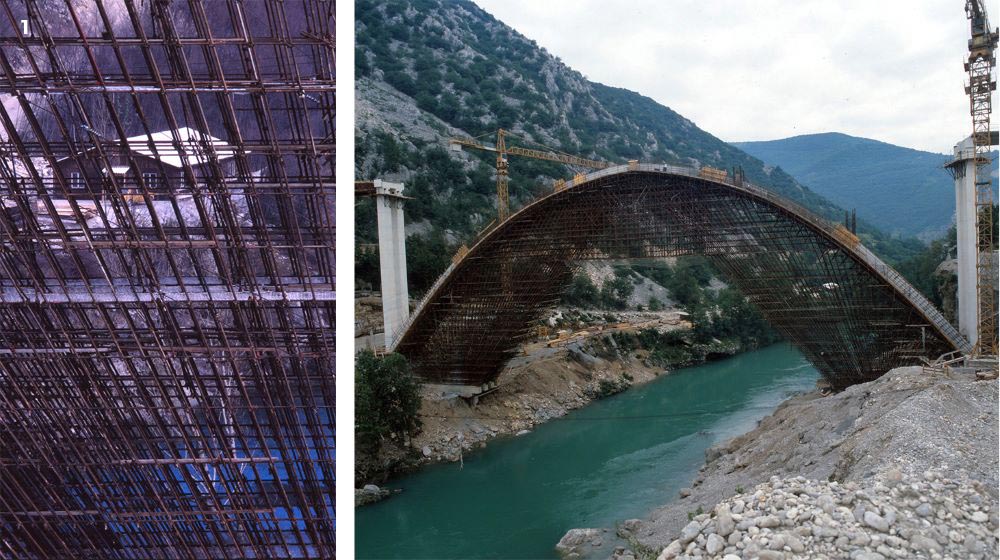

Photo by: Hana Furlan, Bungee jumping
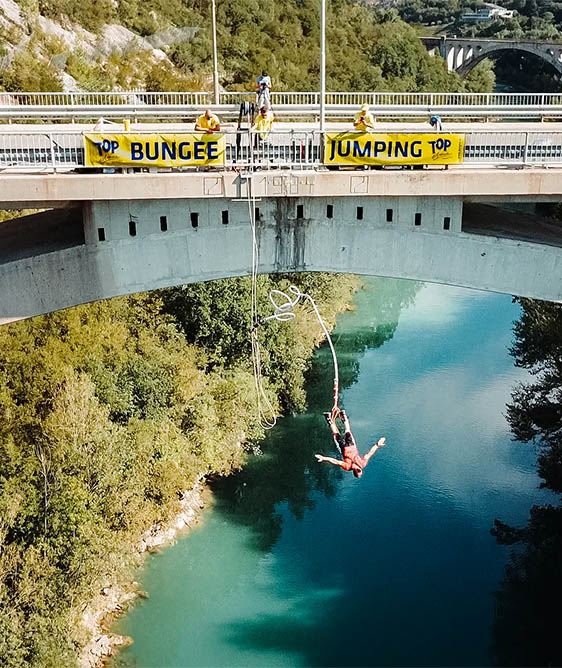
BRIDGE CONSTRUCTION AND STRUCTURAL ENGINEERING
The bridge was designed as a reinforced concrete structure, with a striking 102-metre arch as its primary load-bearing element. From an architectural perspective, this design choice was deliberate and fitting, given the bridge’s proximity to Solkan’s world-renowned stone railway bridge. Any other design solution would have clashed with the surrounding environment.From a geological perspective, the bridge arch was founded, on the Solkan side, on layers of conglomerate, necessitating a special foundation method using piles and geological anchors. On the Mount Sabotino side, where the arch also rests on piles, the foundation conditions were only slightly more favourable. The project’s most significant engineering challenge involved constructing a sophisticated load-bearing scaffolding system for the arch component. The scaffolding foundation, utilizing precision-drilled piles, was strategically positioned at the elevation corresponding to the Isonzo River’s documented 50-year flood level. The arch foundations were deliberately constructed at a higher elevation, positioned above the calculated 100-year flood mark. The scaffolding’s primary function was to support all loads during arch construction. Built with iron tubes arranged in a double-sided fan pattern, the scaffolding system required careful assembly. As construction proceeded simultaneously on both banks of the Isonzo, steel cables anchored the structure to the nearby hill. Once the two sections were joined, the structure gained stability—though the strong winds in the Isonzo valley necessitated additional lateral steel cable reinforcement. The entire load-bearing scaffolding, which contained over 75 kilometres of steel tubes weighing approximately 400 tons, was completed in just over three months.
The concrete installation in the bridge arch required meticulous attention. The concrete was applied symmetrically to both halves according to a precise geometric and time-based schedule. The arch’s cross-section featured a three-chamber box structure made of 20-centimetre-thick concrete. The construction timeline carefully considered the concrete’s slight deformations during curing and ageing. Two high-capacity tower cranes with extended booms facilitated smooth operations throughout both the support scaffolding assembly and concrete placement. The entire arch work, including reinforcement installation, was completed in just three months without any setbacks or delays.
Similar to the arch, the bridge’s supporting columns are hollow. The columns on both riverbanks were completed before the arch, while the upper sections above the arch were built only after the concrete reached sufficient structural strength. The roadway comprises a reinforced concrete slab with circular longitudinal cavities that reduce its weight. The axial spans in this section are 17 metres long.
BRIDGE CONSTRUCTION AND STRUCTURAL ENGINEERING
The bridge was designed as a reinforced concrete structure, with a striking 102-metre arch as its primary load-bearing element. From an architectural perspective, this design choice was deliberate and fitting, given the bridge’s proximity to Solkan’s world-renowned stone railway bridge. Any other design solution would have clashed with the surrounding environment.From a geological perspective, the bridge arch was founded, on the Solkan side, on layers of conglomerate, necessitating a special foundation method using piles and geological anchors. On the Mount Sabotino side, where the arch also rests on piles, the foundation conditions were only slightly more favourable. The project’s most significant engineering challenge involved constructing a sophisticated load-bearing scaffolding system for the arch component. The scaffolding foundation, utilizing precision-drilled piles, was strategically positioned at the elevation corresponding to the Isonzo River’s documented 50-year flood level. The arch foundations were deliberately constructed at a higher elevation, positioned above the calculated 100-year flood mark. The scaffolding’s primary function was to support all loads during arch construction. Built with iron tubes arranged in a double-sided fan pattern, the scaffolding system required careful assembly. As construction proceeded simultaneously on both banks of the Isonzo, steel cables anchored the structure to the nearby hill. Once the two sections were joined, the structure gained stability—though the strong winds in the Isonzo valley necessitated additional lateral steel cable reinforcement. The entire load-bearing scaffolding, which contained over 75 kilometres of steel tubes weighing approximately 400 tons, was completed in just over three months.
The concrete installation in the bridge arch required meticulous attention. The concrete was applied symmetrically to both halves according to a precise geometric and time-based schedule. The arch’s cross-section featured a three-chamber box structure made of 20-centimetre-thick concrete. The construction timeline carefully considered the concrete’s slight deformations during curing and ageing. Two high-capacity tower cranes with extended booms facilitated smooth operations throughout both the support scaffolding assembly and concrete placement. The entire arch work, including reinforcement installation, was completed in just three months without any setbacks or delays.
Similar to the arch, the bridge’s supporting columns are hollow. The columns on both riverbanks were completed before the arch, while the upper sections above the arch were built only after the concrete reached sufficient structural strength. The roadway comprises a reinforced concrete slab with circular longitudinal cavities that reduce its weight. The axial spans in this section are 17 metres long.

Photo by: Hana Furlan, Bungee jumping

THE IMPORTANCE OF THE BRIDGE
On 15 June 1985, the Brda-Collio road and the bridge over the Soča-Isonzo were inaugurated in a ceremonial event. This new connection gave the Goriška Brda (Collio) swift, direct access to Nova Gorica and other parts of Slovenia. The road quickly became essential to the local community’s daily life, fostering rapid economic and social development. Today, it is hard to imagine the dedication required on both sides of the national border to achieve such a successful project. Thanks to this infrastructure, the development of the road network in Goriška Brda was also encouraged, contributing to the progress of the entire area.As cycling tourism has flourished and the Plava-Solkan cycle path opened, bicycle traffic on the road bridge has increased significantly. In response, a pedestrian and cyclist suspension bridge was built near the Solkan Kayak Center in 2022, offering a safe way to cross the Soča-Isonzo River without using the road bridge. The Solkan bridge has gained an additional recreational purpose: bungee jumping. Thrill-seekers now regularly make spectacular jumps from 55 meters above the Soča-Isonzo River.


Photo by: Simon Monfardini




